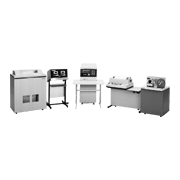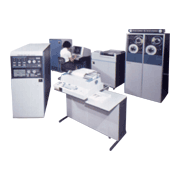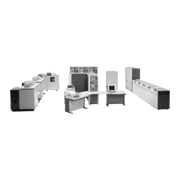These were Fujitsu's mid-size/large machines (the FACOM 230-25 and 35 were mid-size, and the FACOM 230-45 was large) announced in August 1968 as the successors of the FACOM 230 Series. The series was completed as the FACOM 230-5 Series with the later addition of the small FACOM 230-15 (announced in April 1970), the FACOM 230-45S (an enhanced version of the FACOM 230-45 announced in February 1971) and the large FACOM 230-55 (announced in November 1971). These were an "IC computer series" which exploited new technology and were based on technology accumulated through the development of the FACOM 230-60. They were 16-bit machines which took 2 bytes as one word, and they were developed based on a common design concept.
Functionality was upgraded in stages after announcement, and performance was greatly improved. It was very significant that the FACOM 230-25 and 35 in particular worked to double memory capacity by using IC memory for the first time in the main memory unit, and this was the basis for using IC memory throughout in the later FACOM 230-8 Series. The FACOM 230-45S, FACOM 230-25 and FACOM 230-15 were best sellers in the large, mid-size and small machine areas.
| Model name and size |
230-15 | 230-25 | 230-35 | 230-45S | 230-55 | |
|---|---|---|---|---|---|---|
| Small | Mid-size | Mid-size | Large | Large (capable of 2CPU multi- processor configuration) |
||
| Memory unit | Cycle time (Memory element) |
1.5µs/2B (magnetic core) |
1.5µs/2B (magnetic core) |
650ns/2B (magnetic core) |
700ns/2B (magnetic core) |
MEM-I 600ns/4B (plated wire) MEM-II 1.2µs/4B (magnetic core) With ECC function |
| Capacity | 8-32KB | 8-64KB | 32-128KB | 128-512KB | MEM-I 64KB-1MB or MEM-II 128KB-2MB | |
| Operation speed | Binary addition/ subtraction (16bit) |
3.0µs | 3.0µs | 1.3µs | 1.4µs | 0.3µs(32bit) |
| Decimal addition/ subtraction |
28.5µs (5 digit) |
21.75µs (6 digit) |
7.47µs (6 digit) |
7.35µs (6 digit) |
1.2µs (7 digit) |
|
| Floating point addition/ subtraction |
none | 16.5µs | 7.15 µs | 4.55µs | 1.1µs | |
| Max. number of channels | 6 | 6 | 8 | 10 | 32 | |




